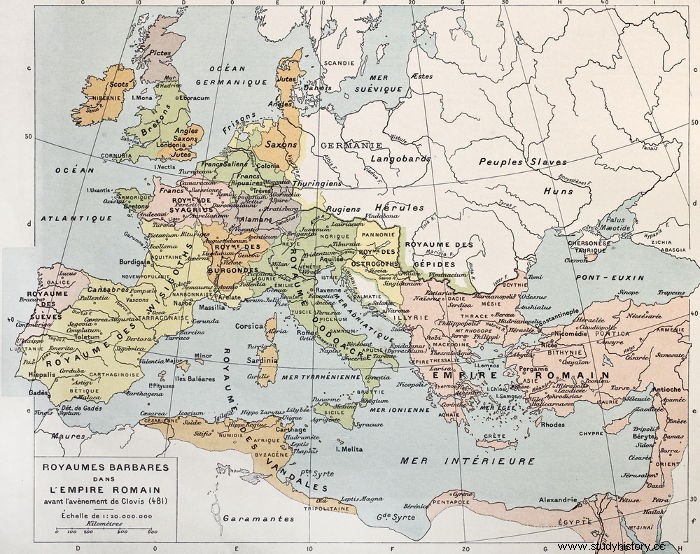
The Germanic invasions during the 4th and 5th centuries they precipitated the process of disaggregation of the Roman Empire . In the territories occupied by the Germanic peoples, new kingdoms emerged from the fusion of Germanic culture with elements of Latin culture (Roman). The transformations carried out since the establishment of the Germans shaped medieval society.
Germanic Peoples
The Germanic peoples were pejoratively called by the Romans as barbarians for not sharing the same customs and language as the Romans. This designation comes from the name given to the region they inhabited:Germania . From the 2nd century AD, during the reign of Marcus Aurelius, the Romans constantly fought the Germans on the borders of the Empire.
With the decay of the Roman Empire, the containment of the Germanic peoples became increasingly difficult. Thus, the Empire began to assimilate the Germanic peoples, admitting them into their lands. There was, with this, the integration of Germanic warriors to the Roman armies and cases of Germans who managed to occupy positions of importance within the Roman Senate. From the 5th century onwards, the Germanic migration process reached a catastrophic character and took on greater proportions of violence.
Causes of invasions
The causes of the Germanic invasions are uncertain for historians, but there are some indications that allow us to better understand the subject. Some historians claim that growth demographic led the Germanic peoples to migrate in search of more fertile lands. It is also hypothesized that changes climatic have generated a cooling of the climate and affected the survival of the Germans, who were forced to look for better lands to survive.
There is still agreement among historians about the arrival of the Hun peoples , coming from Asia. The arrival of the Huns brought despair among the Germanic peoples, who began to exert increasing pressure on the borders of the Roman Empire.
The Huns caused the migration of Ostrogoths , Visigoths , Alans , Burgundians , Suevi , Vandals and many others to the lands of the Roman Empire. Some of them gained asylum in the Empire, and others forced their way in from armies. The process of the breakup of the Roman Empire took place when the last Roman king was overthrown by the Heruli in 476 AD.
Consequences

Map showing the establishment of the Germanic kingdoms after the breakup of the Roman Empire in 476 AD
The Germanic migrations resulted in the process of dissegregation of the Western Roman Empire. Thus, the power centralized in Rome ceased to exist, and the lands were occupied by the Germans, who prevailed by force.
In addition, there was also ruralization of Europe, because, with the food production centers attacked and the trade routes closed, the supply of the cities was interrupted, generating famine in the great Roman cities. There were also cases of disease epidemics in large cities, in addition to looting carried out by Germanic peoples. This generated a migration of population to rural areas in order to escape violence and be close to food production sites. This process also resulted in population decline from Europe.
From the Germanic peoples, new ones realms appeared, as the Kingdom of the Franks, the Kingdom of the Visigoths, the Kingdom of the Ostrogoths, etc. The fusion of Latin and Germanic culture gave rise to the culture of Western society. Furthermore, the structure of these societies made possible the emergence of the characteristics that defined Europe during the feudal period.
by Daniel Neves
Graduate in History
